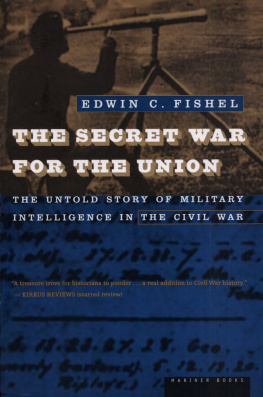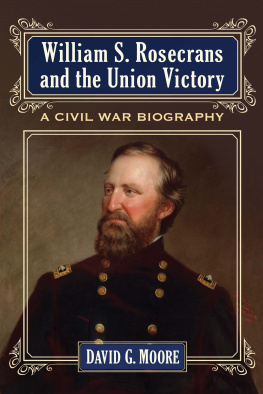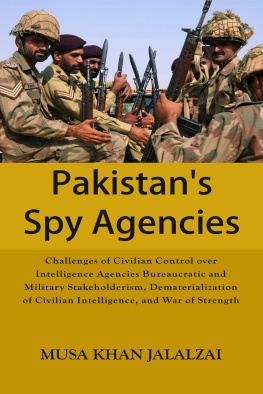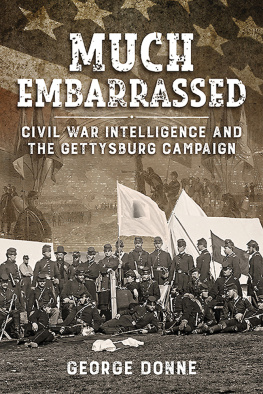
Copyright 1996 by Edwin C. Fishel
ALL RIGHTS RESERVED
For information about permission to reproduce selections from this book, write to Permissions, Houghton Mifflin Harcourt Publishing Company, 215 Park Avenue South, New York, New York 10003.
www.hmhco.com
The Library of Congress has cataloged the print edition as follows:
Fishel, Edwin C.
The secret war for the union : the untold story of military intelligence in the Civil War / Edwin C. Fishel.
p. cm.
Includes bibliographical references and index.
ISBN 0-395-74281-1
ISBN 0-395-90136-7 (pbk.)
1. United StatesHistoryCivil War, 18611865Military intelligence. 2. Military intelligenceUnited StatesHistory19th century. I. Title.
E 608. F 57 1996 96-12741
973-7'85dc 20 CIP
e ISBN 978-0-544-38813-0
v1.0614
Thanks are due to Kent State University Press for permission to reprint portions of the authors article Pinkerton and McClellan: Who Deceived Whom? Civil War History, 1988.
For Gladys, Reverdy, and Katie
List of Illustrations
Beginning
Allan Pinkerton with William Moore, George H. Bangs, John Babcock, and Augustus K. Littiefield. Millers Photographic History
General George B. McClellan. National Archives
Colonel Lafayette C. Baker. National Archives
Colonel George H. Sharpe, John Babcock, Lieutenant Frederick L. Manning, and Captain John McEntee. Millers Photographic History
General Joseph Hooker. Millers Photographic History
General Daniel Butterfield. National Archives
General Marsena R. Patrick. National Archives
Captain William J. Palmer. Military History Institute
William Wilson. Millers Photographic History
General John Pope. National Archives
General Alfred Pleasonton. National Archives
David McConaughy. Authors collection
Belle Boyd. National Archives
Rose Greenhow and her daughter, Rose. Millers Photographic History
Elizabeth Van Lew. Authors collection
Colonel Albert J. Myer. Authors collection
General George G. Meade. National Archives
Butterfields draft of the hoax message that deceived Lee. National Archives
The Federals intercept of the Confederate decode of the hoax message. Hooker Papers
John Babcocks report of the depleted condition of Lees army at Gettysburg. National Archives
The signal officers oath of secrecy given by Edward Porter Alexander. Authors collection
Order-of-battle chart of Lees army. Hooker Papers
List of Maps
Region of First Bull Run Campaign
The Northern Virginia Theater
The Peninsula Campaign
Shenandoah Valley
Region of Second Bull Run Campaign
Region of the Antietam Campaign
Region of the Fredericksburg Campaign
Region of the Chancellorsville Campaign
A Section of the Chancellorsville Battlefield
Hookers Advance to Chancellorsville
Situation, 5 P.M. , May 2, 1863
Situation, Afternoon, May 4, 1863
Lees Positions, May 27, 1863
Region of Captain McEntees Operations
Situation, Morning of June 13, 1863
Ewells Attack on Winchester
Situation, June 20, 1863
Ewells Marches in Maryland and Pennsylvania
Lees Advance into Maryland
Situation, P.M. , June 24, 1863
Lees Advance into Pennsylvania
Situation, P.M. , June 28, 1863
Situation, Night of June 30, 1863
From Gettysburg to Appomattox
Foreword
BY STEPHEN W. SEARS
IN OCTOBER 1959, at the National Archives in Washington, Edwin C. Fishel made a discovery that was, in the context of Civil War historical research, sensational. In what he has described as a half-roomful of miscellaneous records of the Army of the Potomac were bundles of documents he had no idea still existedthe operational files of that armys Bureau of Military Information, arranged with bureaucratic thoroughness and nearly tied with red tapes. They had been undisturbed for nearly a century. Fishel had discovered the first building block for what would beand isthe first authentic history of military intelligence in the Civil War.
It is truly remarkable that after all these decades, after the publication of more than 50,000 books and pamphlets, there could be a major gap in our knowledge and understanding of the Civil War. Certainly no period in our national history has been so minutely examined as the years 1861 to 1865. Yet until now we have known almost nothingnothing authenticof the critically important role of intelligence in Civil War campaigns. The Secret War for the Union is a truly groundbreaking story.
To be sure, in the vast Civil War library there is already a shelf devoted to espionage or intelligence tides. To the serious student of that war it is a sad array, the repository of (in publishings apt slang) the potboiler. These books are descended from the memoirs of men and women who claimed, not all of them truthfully, to have been spies for the Union or the Confederacy. Later writers have added liberally to the numerous fictions and occasional facts in these books. The literature thus created tells mainly of spies trials and tribulations; if it touches on the outcome of battles, it vastly exaggerates the spys contribution and tells nothing that helps us understand the commanders decisions and actions. And it treats espionage as the be-all and end-all of intelligence, ignoring, for example, important information from balloonists and signalmen with their telescopes.
Edwin Fishel went on from that 1959 discovery to find intelligence records in other sources. He cast his net widely. General McClellans papers, which had been available to researchers for nearly a century, contained, among much else of interest, more than a thousand pages of reports by his intelligence chief, detective Allan Pinkertona gold mine untouched by the potboiler writers. The privately held papers of General Hooker, originator of the Bureau of Military Information, yielded a trove of the bureaus reports. These, combined with the reports in the bureaus files, reveal that its officers integrated information from all types of sourcesspies, scouts, cavalry, balloonists and Signal Corps observers, and interrogation of prisoners and deserters. This analytic operation is a milestone in the history of United States intelligence.
But putting previously unexploited sources to use does not make a definitive study. That goal required interpretation of the often disparate evidence in these documents, drawing on Fishels thirty years of experience in the United States intelligence service. Thus we have a fully crafted intelligence history of each campaign examined, with intelligences hits and misses, successes and failures. In these pages, for the first time, are answers to some of the most tantalizing whys of the war.
Walt Whitman, fresh from witnessing the effect of the Civil War on Americans of his time, offered an oft-quoted observation that the real war will never get in the books. The Secret War for the Union takes us one very important step closer to that real war.
Introduction
I N PRESIDENT LINCOLNS VIEW , intelligence was the hardest nut to crack in the grand strategy that would defeat the Confederacy. Writing to his western generals early in 1862, Lincoln said that knowledge of enemy movements was the most constantly present, and most difficult of the problems to be solved if the Union was to maneuver its forces so that their superior numbers could be brought to bear to offset the Confederates advantage in having interior lines, which meant shorter marches to any point of concentration.
Next page









